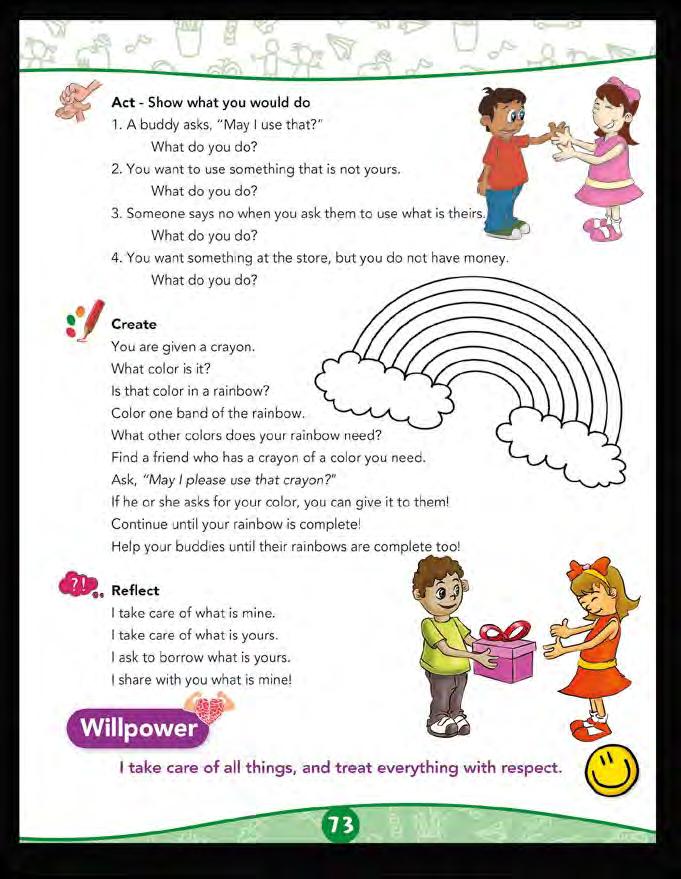
4 minute read
Lesson 5: Faces and Feelings
Materials
My Best Me textbook, writing and coloring utensils (including crayons), audiovisual equipment
Advertisement
Resources
Student Worksheet: 4yu.info/?i=V5981328 Family Engagement: 4yu.info/?i=V5981378 Video: 4yu.info/?i=V59813281 Respect and Take Care of Things video
Motivation

Our society is one where you can buy anything you want, whenever you want it. In some sense this has caused a devaluation of things in general and the tendency not to take care of things to the extent that we could at times. Children learn by watching the adults in their lives, and when they observe how we treat the things around us and with what ease we purchase and dispose of things, a message is sent and received that things have little to no value, and it does not really matter if those things belong to others. By the time children reach kindergarten they are usually familiar with being told to share and not to take what is not theirs. These basics of respecting ownership, as well as being generous and patient when it comes to taking turns with community items or resources, are important to build upon as children’s social, emotional and cognitive development increases. Children need to learn to share so they can make and keep friends, play cooperatively, take turns, negotiate and cope with disappointment. Sharing teaches children about compromise and fairness. They learn that if we give a little to others, we can get some of what we want too. Practicing sharing and taking proper care of items that they are responsible for develops their value for others and for things they have the opportunity to use. Children are also more motivated to exercise stewardship when they understand the value it brings to their environment, such as that things stay in better condition, it causes their authorities to entrust them with more, and it helps them maintain orderly and functional spaces.


Goal
Students will discover how to respect ownership and to care for their own and others’ belongings.
Observe: Read the Observe section to the class. Ask students to think of some things they share with others and things they do not share. Call on students to share. Point out that they should take proper care of their personal things, as well as the things they share. Ask how we take care of important items. Have students brainstorm and call on them to answer. Draw: Instruct your students to circle the things that belong to them personally. Allow the students to discuss what makes the items different.
Pathways

Ask them why taking care of the things that they own is important. Ask the same about things they share and things they borrow from others. Emphasize how things stay in better condition longer when we care for them, and how others feel respected when we take care of their things. Watch: Play the video for all students to see. Allow students to ask questions, such as “How did the girl take care of her pencils?” and “What actions helped take care of the park?” Play the video a second time for reinforcement purposes, as desired. Comment: Ask comprehension questions. Allow students to ask questions and come up with solutions for taking care of different things. Optional: Give examples of commonplace things that can be taken care of at home (dishes that need to be washed, clothes that need to be folded, toothbrushes that need to be rinsed, beds that need to be made, and toys that need to be picked up and set in their places). Have students do motions that act out each one. Concerning their care for “other people’s” things, students should really learn the concept that caring for stuff that is not theirs should be better, because if something happens to it they might have to replace what was damaged or broken. Act: Divide the classroom into smaller groups. Read each situation out loud, and give each team time to think of solutions. Ask each team to demonstrate the solution they thought of with words and motions, or simply act out with motions, in front of the class. Create: Give each student one crayon, but different colors to each student. Ask them to color in one line of the rainbow. Once everyone has colored in one line, ask them what other colors they need to finish the rainbow. Instruct them to find a friend with the crayon they need and ask them for it properly. Ask the students to keep trading crayons until their rainbow is complete. Reflect: Ask the students to repeat the Reflect statement as a class. Ask the class for volunteers to give examples of times they shared something with a friend, or took proper care of something. Offer positive reinforcement for this by having the whole class clap after each example.

Willpower
Repeat the Willpower statement as a class. Decide on hand motions that accompany it. Repeat it with the motions as a class.

